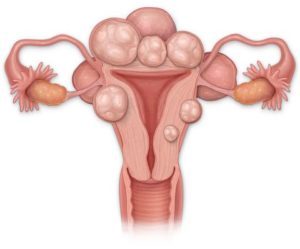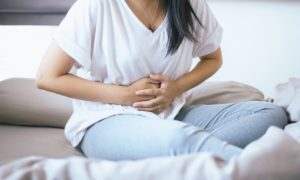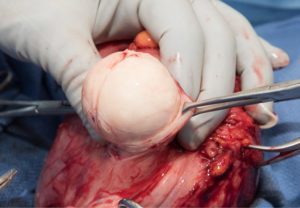Fibroid is a type of non-malignant growth on the walls of the uterus. It is also known as leiomyoma. There are many types of fibroid – they range of different sizes and different locations on the walls of the uterus.
Less than 1% of these fibroids are capable of turning malignant, which are called leiomyosarcoma.
Fibroids occur frequently in women. They can exist unnoticed. In every 3 women, one will have fibroid.

Picture source: Cosmopolitan
There are various sizes of fibroids ranging as small as milimeters to as large as 10cm. Fibroids are named by its location. It is important to note that generally, fibroids do not cause any problems because most of the time, its existence is not noticed. The problems that may occur due to fibroids are heavy bleeding during menstruation, period cramps, sensation of pressure on the bladder or rectum that makes you feel like urinating or passing motion but nothing comes out, or pain.
Fibroids are related to the female hormones estrogen and progesterone. Therefore, on reaching menopause, the supply of these hormones stop and causes the fibroids to shrink in size. However, if the fibroids do not reduce in size after menopause and multiplies instead, this may indicate that the fibroids are malignant (leiomyosarcoma).
Why do fibroids occur?
All experts and research show that the true cause and origin of fibroids are unknown.
Many research results indicate that fibroids are related to the female hormones as I have explained earlier, hence the relation between obesity and fibroids.
Why obesity? Excess fat collected in the body stores estrogen and progesterone. The high hormone content is said to be the cause of fibroids.
Symptoms of fibroid

Picture source: Bustle
The symptoms listed below are not specific to those who have fibroids. This means fibroids are not the sole cause of the following:
- Abnormal heavy bleeding during menstruation
- Excessive debilitating pain during menstruation that affects going to work, college or school and requires medical leave.
- Sensation of a bloated tummy. Can be mistaken as fat but is actually swelling of the uterus or ovaries.
- Frequent urinating. Feeling as if you still need to urinate soon after doing so. Large fibroids can put a pressure on the bladder which makes you feel you need to urinate often.
- Pain under the stomach region when not menstruating. This is caused by degenerative changes in the fibroids.
- Difficulty to conceive. When the ovum has been successfully fertilized, it does not implant for long on the walls of the uterus. Fibroids on the uterus walls can affect implantation of the fertilized egg and may result in a miscarriage. However, fibroid is not the only cause of the miscarriage, other factors count into play as well.
- For those who are pregnant, fibroids at the lower end of the uterus may disrupt the rotation of baby in the womb.
- Large fibroids that hang outside the uterus may twist (fibroid torsion) causing pain.
What are the treatments available for fibroids?
Non-malignant, asymptomatic, or small fibroids do not need to be removed and do not require any treatment. Fibroids will usually reduce in size and disappear on its own after menopause.
There are hormone pills that can be prescribed as a first treatment. This option is something that can be discussed with your doctor.

Picture source: Iluminasi
Fibroid removal surgery. There are two types : to remove the fibroid only and leave the uterus intact if the patient plans for a future pregnancy or removal of fibroid with the uterus. However, there is a risk of bleeding and would require removal of the uterus. There are cases where the uterus needs to be removed with the fibroid especially when the doctor suspects the fibroid to be malignant or there is no reduction in size after menopause. Smaller fibroids that affects fertility or causes heavy bleeding during menstruation can be removed by hysteroscopy. Every procedure carries a risk of complication. Patients are strongly recommended to discuss with their doctor to find out the best course of treatment.
Surgery is the final option if medications are not successful in treating fibroids.
Every course of treatment requires clinical assessment and a medical check by a doctor.
The original article in Malay by Dr Muhammad Izzat bin Abdul Razak, an obstetrician and gynaecologist at a hospital in Selangor is accessible via https://www.mmgazette.com/fibroid-ketahui-punca-gejala-dan-rawatannya-dr-muhammad-izzat/ . Translated by Nur Nadhirah
Reference:
Heavy menstrual bleeding : assessment & management NICE guideline published 14 March 2018
[This article belongs to The Malaysian Medical Gazette. Any republication (online or offline) without written permission from The Malaysian Medical Gazette is prohibited.]
